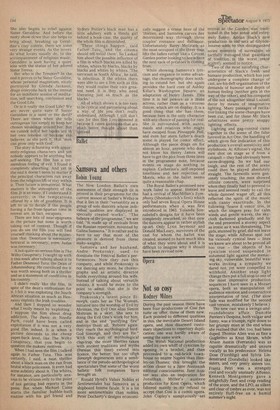Ballet
Samsova and others
Robin Young
The New London Ballet's own assessment of their strength (it is printed in their programme for the current season at Sadler's Wells) is that it lies in their "versatility as a group of solo dancers whose individual qualities are displayed in specially created works". "The balance of the programme," we are told, "is made up of revivals from the Russian repertoire, mounted by Galina Samsova." It is rather sad to have to say that most of the pleasure is derived from these make-weights.
Samsova and her husband, Andre Prokovsky, used to dominate the Festival Ballet's performances. Now they run this company, and while Prokovsky is not dancing any more, he choreographs and as artistic director builds everything around his wife. Instead of talking about versatile soloists, it would be more to the point to admit that she is the company's strength.
Prokovsky's latest piece Simorgh, casts her as The Woman, initiated into the worship of Evil by Ahriman, the Evil One alias Simon Mottram in a skirt. She sets to doing the Evil One's work for him, and in the end "purifying fire" destroys them all. 'Reborn again, they reach the mythological birdGod Simorgh, and they are He," With this sort of mythological clap-trap, the more liberties taken with ancient traditions and myths (Persian this time) extend into licence, the better; but too oftvh Sirnorgh degenerates into a semblance of the pseudo-anthropological spectaculars that some of the worst balletic folk companies have brought us.
Ronald Hynd's Valses Nobles et Sentimentates has Samsova as a shipboard femme fatale. It is a lot more sentimentales than nobles. Peter Docherty's designs economi cally suggest a cruise liner of the 'thirties, and Samsova carves her determined way through three couples' romance and dalliance. Unfortunately Barry McGrath as the most occupied of the three men lifts the ladies rather like a Covent Garden porter looking to see where the next sack of potatoes is coming from.
While showing Sarnsova's lyricism and elegance to some advantage, the choreography does nothing to extend her, but she again provides the hard core of Ashley Killar's Washington Square, an adaptation of Henry James. This time it is her powers as a mute actress, rather than as a virtuoso dancer, which are on display. It is a good thing that she has them, because hers is the only character with any chance of passing for real: She is surrounded with aunts, maids and relatives who might have escaped from Pineapple Poll, and even her stern father's death scene is played for comic effect. Although the piece drags on for almost an hour, anyone who does not know his Henry James will have to get the plot from three lines in the programme note, because events on stage do nothing to explain Catherine's self-imposed loneliness and her rejection of Morris, who in the ballet seems quite a reasonable chap.
The Royal Ballet's promised new work failed to appear. Instead we had a revival of MacMillan's Symphony (Shostakovich's first) which only had seven Royal Opera House performances when it was first introduced in 1963. Yolanda Sonnabehd's designs for it have been completely reworked, so that now the dancers appear in rather stylish op-art. Only. Lynn Seymour and Donald MacLeary, survivors of the cast for whom the ballet was created, seemed to have much idea of what they were about and it is difficult to imagine why it should have been revived now.


































 Previous page
Previous page